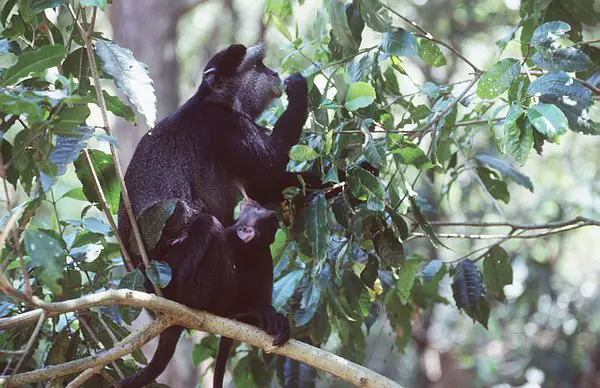Blue Monkeys
The Blue Monkey is an elusive and rather shy inhabitant of the African jungle. Despite their name, the Blue Monkeys aren’t actually blue, but gray instead. Their habitat ranges from the Eastern part of South Africa up to Zimbabwe, Kenya and Kongo.
Blue Monkeys are among the largest members of the monkey family and are known for their beautiful, soft fur.They reach a length of 40-70 cm, while their tail is as long as 70-100 cm. The monkey’s fur is thick and soft, the feet are dark brown or blueish black, while the back is brown to gray. Blue Monkey’s hind feet are longer than the forefeet, thus the monkey’s movement style seems rather bizzare.
This animal spends most of its time in the very higher tree branches. Blue Monkeys live in groups made of 10-30 females and one mature male, while the males that are not in a group live alone. The monkeys are active in early mornings and later in the evening. The hot part of the day is spent covering in the shadows of dense growths, where members of the group tend each other’s fur, thus strengthening their relationships.
When looking for food, the whole group moves through their territory. Blue Monkeys feed mostly on fruit, seeds, leaves and even tree bark. This vegetarian diet is supplemented by various bugs, lizards, birds and even small mammals. African farmers consider these monkeys pests, because they sometimes destroy crop. The Blue Monkey is an extremely agile animal – it easily jumps from one treetop to another and in the trees it moves faster than a man can run on the ground.
The mating period depends on the area in which the monkeys live in. In wet tropical forests, mating most often occurs during the dry period, while in other territories it usually happens in fall. All the females are fertilized by the single male, or sometimes, if there are two females ready to copulate at the same time, a temporary guest male is introduced, who leaves the group soon afterwards. The alpha male of the group doesn’t spend very much time in the group – most often only a few weeks, and very rarely more than one year, although during this time they’re indisputable leaders of the group.
A female usually gives birth once every two years. After a gestation period of 5-6 months, a single baby monkey is born. They develop fairly quickly, and soon start walking on their own, learn to gather food, move through the trees, and also become socializing with other members of the group. They reach sexual maturity after 5-6 years and at that time the young males leave the group to lead either a solitary life or to find a female group in need of a male. Female baby stays in the mother’s group for the rest of their lives. Blue Monkeys can live for 20-30 years in captivity.



